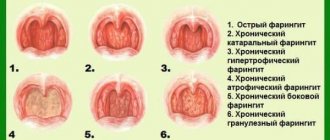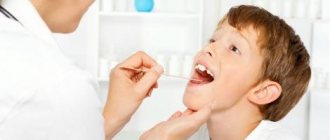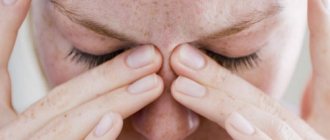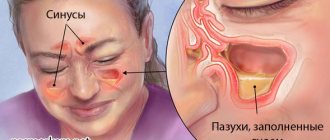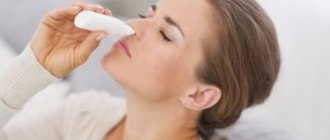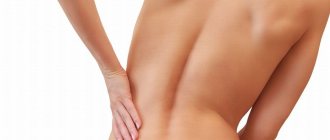Etiology, causes of acute rhinosinusitis
The primary source of infection of mucous membranes is considered to be pathogens of viral origin. Rhinoviruses, influenza and parainfluenza viruses, adenoviruses and others have the greatest affinity for these tissues.
Due to the toxic effect of the pathogen, the protective mechanisms of the ciliated epithelium are disrupted, as their normal motor activity changes. Favorable conditions are created for the introduction and activation of bacterial agents, followed by purulent exudation in the lumen of the air sinuses.
In the development of acute sinusitis with a purulent component, the leading role belongs to staphylococci and pyogenic streptococci.
Other factors that can provoke the development of the disease include: congenital or acquired curvature of the nasal septum, anomalies in its structure, allergic rhinitis, the influence of occupational hazards or environmental conditions, smoking, reduced immunity.
Therapeutic measures
If you treat a runny nose using traditional methods without consulting a doctor, the disease will quickly develop into a complicated form. Without test results and without knowing the causes of a runny nose, it is impossible to choose the optimal therapy. This is why it is important not to self-medicate.
Once the diagnosis is confirmed, drug therapy is prescribed. Bacterial polysinusitis is treated with drugs such as Ceftriaxone, Amoxicillin, Azithromycin, etc. Before using these drugs, it is recommended to determine the sensitivity of the nasal flora to antibiotics. It is worse if allergic rhinitis joins the existing disease.
The course of treatment usually does not exceed two weeks. The patient is prescribed both antibacterial drugs for internal use and drops with an antibacterial effect in the nose. The latter are preferable in the treatment of children, on whom broad-spectrum antibiotics have extremely negative effects.
Complex therapy includes:
- the use of vasoconstrictor drugs - facilitate the patency of the nasal canals, relieve swelling. Usually do not apply more than 5 days in a row. Such products as Naphazoline and Okismetazoline have proven themselves well. Less aggressive formulations are used to treat infants;
- thinning mucus - for this purpose, mucolytic drugs and secretolytics are prescribed, for example, Rinofluimucil;
- relief of allergic reactions is mandatory in case of hypersensitivity to drugs or in the presence of chronic rhinitis. For this purpose, “Allergocaps”, “Allergodil”, “Loratadine”, etc. are used;
- nasal rinsing is carried out using saline solution. Allows you to remove pus, thick mucus and prevent the development of congestion.
The purulent form involves puncturing the nose to extract pus and prevent complications. The procedure is carried out under local anesthesia and involves through penetration through a direct channel directly into the sinus. Under great pressure, the pus comes out. In parallel, classical drug therapy and physiotherapy are carried out.
Clinic, symptoms of acute rhinosinusitis
The clinical picture of intoxication syndrome begins to recede, and local signs of acute rhinosinusitis come to the fore.
Against the background of a “fading” viral infection, the patient develops persistent congestion of the nasal passages, as a rule, the process is bilateral (unilateral damage occurs less often). Nasal discharge is difficult, thick, and may be white or yellow-green (with a bacterial infection).
The sense of smell decreases, the patient ceases to feel the natural smell and taste of food. The voice changes its timbre and acquires a nasal character.
Painful sensations vary in nature and intensity, depending on the location and severity of the disease:
- sinusitis manifests itself as typical pain in the cheek area, which intensifies when the head is tilted down;
- with frontal sinusitis, patients complain of pain in the frontal part of the head;
- with ethmoiditis and sphenoiditis, the headache is diffuse.
Acute and chronic rhinosinusitis: stages of the disease
Rhinosinusitis develops in 2 stages, each of which shows how inflamed the sinuses are:
- First stage
The first stage of inflammation is called acute catarrhal rhinosinusitis. Clinical symptoms differ little from a common runny nose: the patient experiences heaviness in the bridge of the nose, which develops against the background of nasal congestion.
On the 3rd day, inflammation flows into the paranasal sinuses, causing swelling of the mucous membrane. If a person does not recover, then a new stage of rhinosinusitis begins.
- Second stage
Stage two – acute purulent rhinosinusitis. Inflammation occurs in the sinuses and is caused not by viruses, but by bacteria. Swelling of the mucous membrane occurs in the anastomosis, and pus accumulates in the sinuses near the nose. All this is accompanied by:
- elevated body temperature
- weakness
- pain in the cheeks or head
Rhinosinusitis occurs in mild, moderate or severe form. In the first form, symptoms are mild and x-rays do not show fluid in the sinuses near the nose. The average form is characterized by an increase in body temperature to 37.5 degrees, pain when touching the cheeks, headache and the appearance of fluid in the paranasal sinuses.
In severe forms of rhinosinusitis, the body temperature reaches 38 degrees, and when you touch the area of the paranasal sinuses, severe pain appears. A severe form is diagnosed using an x-ray. The image shows that the sinuses are completely filled with fluid. A complication may be vasomotor rhinosinusitis.
Complications
Inadequate or untimely treatment can lead to a number of serious complications:
- introduction of the pathogen into the epithelium of the respiratory tract, which leads to bronchitis or pneumonia;
- purulent spread of the contents of the sinuses into the substance of the brain, with the development of abscesses of various locations, meningitis, encephalitis;
- thrombotic changes in the cavernous sinuses;
- purulent melting in the tissues of the orbit, which can cause the patient to completely lose vision;
- septic condition of the body.
Features and symptoms of sinusitis
Sinusitis is a group of infectious pathologies in which there is inflammation of the sinuses - the paranasal sinuses. The location of the paranasal voids can be seen in the photo. This pathology usually occurs in childhood, but adults also often suffer from its manifestations. This group includes the following diseases:
- Sinusitis is an infection of the maxillary (maxillary) sinuses.
- Frontitis is a lesion of the sinuses of the frontal lobe.
- Ethmoiditis is an infection of the cells of the ethmoid bone of the labyrinth.
- Sphenoiditis is an infection of the sphenoid sinus.
If inflammation occurs simultaneously in several sinuses, the diagnosis is polysinusitis. Infection of the sinuses on one side is commonly called hemisinusitis. The most severe form of the disease is pansinusitis - inflammation of all paranasal sinuses. The development of sinusitis is usually preceded by a cold, bacterial infection, or allergic reaction.
This disease occurs in 2 forms:
- Acute sinusitis. The pathology is treated for a couple of months, after which it finally goes away.
- Chronic sinusitis. Even long-term complex treatment does not guarantee full recovery; the disease returns in the presence of predisposing factors.
Lack of treatment threatens the pathology becoming chronic and causing serious negative consequences.
Diagnostics
The development of characteristic complaints allows the doctor to suspect the disease. There is always information about the previous viral process. For acute bacterial rhinosinusitis, the following criteria are taken into account:
- an increase in the duration of a common respiratory infection beyond 7-10 days or a deterioration in general health after these periods;
- the patient develops purulent nasal discharge;
- pain occurs in the projection of the sinuses, which intensifies with palpation.
Local pain and swelling of the affected sinus are objectively determined, redness of the skin is possible.
The hemogram indicators indicate the inflammatory course of the disease (leukocytosis, accelerated ESR).
Culture of nasal secretions and determination of antibacterial sensitivity.
Instrumental examination:
- Targeted rhinoscopy evaluates the mucous membranes of the nasal turbinates and anastomoses with the paranasal sinuses; purulent discharge due to a bacterial process is detected.
- X-ray of the sinuses helps to visualize the level of fluid in the affected cavity and the parietal swelling of the tissues.
- Ultrasound of the maxillary sinuses (but this method does not always allow accurately diagnosing the disease).
- Computer examination (CT) is the most informative method, as it allows you to establish the localization and extent of the process. A typical sign of acute rhinosinusitis is total darkening of the lumen and thickening of the sinus mucosa.
Treatment of polysinusitis in children
It is an axiom to treat polysinusitis in children than in adults. It is often dangerous to perform operations and punctures on a fragile body; in addition, some of the drugs used in the classic drug cycle have a very negative effect on the growing body.
An effective and efficient means of combating the disease in this case is nasal rinsing using specially created systems and teapots that facilitate the process of introducing fluid into the nasal sinuses.
When treating polysinusitis and children, greater emphasis should be placed on topical drugs - they are practically not absorbed into the blood and are not processed by the stomach and liver, which in turn frees the child from the need for an additional restorative course and reduces the risks of complications from the kidneys, liver and hearts.
The optimal course of treatment is vasoconstrictor drugs (Nazol Baby, etc.), rinsing/dropping with Salin or analogues, the use of antihistamines and combined nasal sprays, including antibiotics, corticosteroids and mucolytic herbal components (Corralgol, Polydexa, Bioparox, etc.) .
Treatment of acute rhinosinusitis
- Antibacterial agents are prescribed only when the disease is bacterial in nature. The goal of therapy is to combat the pathogen and eliminate the inflammatory component, as well as prevent chronicity of the disease. The most common treatment error is the prescription of antibiotics for viral etiologies of the process. First-line agents include representatives of the penicillin series and 3-4 generation cephalosporins. Taking into account the severity of the condition and the choice of drug, treatment is continued for 7 to 14 days. Preference is given to monotherapy, but if the process is severe and there is resistance to certain antibiotics, combinations of drugs are prescribed.
- Vasoconstrictor medications will help reduce the inflammatory and edematous components of rhinosinusitis as much as possible. They help “open” the natural ducts between the sinuses and turbinates. It is not recommended to use this group of medications for more than 10 days (an ENT consultation is required).
- Local irrigation of the nasal cavity with solutions based on antiseptics, antibiotics or agents with antiviral activity, rinsing the nasopharynx with sea salt.
- To restore the natural balance between mucus production and its evacuation from the lumen of the sinuses, mucolytics and secretolytic agents are prescribed. They are able to dilute the secretion and speed up the work of the ciliated epithelium.
- Immunostimulating agents can speed up recovery and protect the body from the disease becoming chronic.
- Antipyretic and analgesic medications are used extremely rarely; for this, the severity of the disease and the patient’s subjective sensations are taken into account.
- As the acute component subsides, physiotherapeutic methods of treatment (UV irradiation, UHF, paraffin therapy and others) are widely prescribed.
- Puncture of the affected sinuses is carried out for both therapeutic and diagnostic purposes. It allows you to quickly evacuate all contents and carry out the necessary antibacterial and antiseptic treatment.
- The use of a YAMIK catheter allows you to evacuate purulent contents from the affected sinuses without puncture.
How to properly treat acute sinusitis
Acute sinusitis is subject to complex treatment, which differs from what is used for colds. Therapy is aimed at changing thick or purulent exudate to transparent mucous. It is difficult to get rid of discharge from sinusitis; the process of blowing your nose can cause bleeding or stuffy ears. Please note that taking plenty of fluids, strengthening the immune system, and eliminating the factors that triggered the development of the disease are the main treatment measures.
As a rule, when treating sinusitis, the doctor prescribes rinsing the nasal passages with saline solution in combination with vasoconstrictor drops or sprays. Please note that the use of pharmaceutical products must comply with the instructions. Good drugs are Aqua Maris, No-Sol or Humer. They cannot be used for more than a week, as such drops become not only useless, but also cause addiction.
For the bacterial form, the doctor selects antibiotics based on culture results. For reference, here are examples of the most effective antibacterial drugs: Bioparox, Isofra, Amoxiclav, Ospamox, Doxibene.
If the disease is allergic in nature, then treatment consists of reducing contact with the source of the allergy and using special products: Rhinocort Aqua, Flonase, Beconase. If the patient complains of severe headaches, the doctor may prescribe a pain reliever, such as Aspirin.
Is it possible to warm up the nose if you have sinusitis? This procedure is recommended, but not in all cases. If the disease occurs without fever and severe inflammation, then heating is safe. For purulent sinusitis, this method will effectively remove pus and make breathing easier. Inhalations with a nebulizer are also often used.
If you follow all the doctor’s recommendations, treating sinusitis at home takes no more than 10 days. Please note that self-medication can be not only ineffective, but also dangerous. To avoid negative consequences and complications, consult your doctor before using medications.
Where to go? ENT clinics in Moscow:
Atlas Medical Center on Kutuzovsky Prospekt Moscow, Kutuzovsky Prospekt, 34, building 14 SM-Clinic on Klara Zetkin Moscow, st. Klara Zetkin, 33, bldg. 28 Medical clinic NACFF Moscow, st. Ugreshskaya, 2, building 7 European Medical Center in Orlovsky lane. Moscow, Orlovsky per., 7 Medical center Family clinic on Kashirka Moscow, Kashirskoye sh., 56 Medical center Family clinic on Izmailovskaya Moscow, st. Pervomaiskaya, 42 All ENT clinics in Moscow on the map
